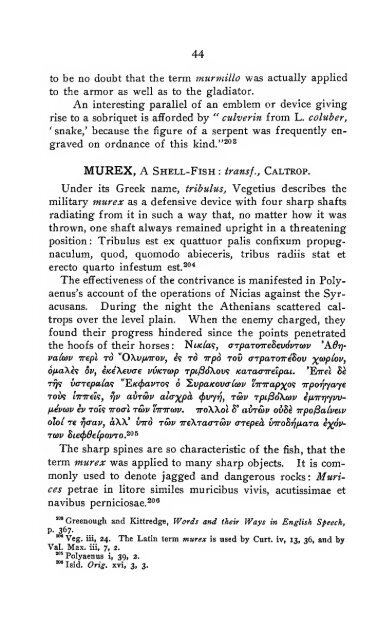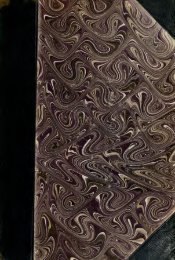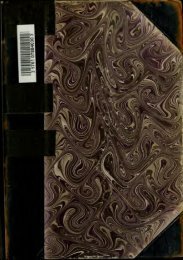Figurative uses of animal names in Latin and their ... - mura di tutti
Figurative uses of animal names in Latin and their ... - mura di tutti
Figurative uses of animal names in Latin and their ... - mura di tutti
You also want an ePaper? Increase the reach of your titles
YUMPU automatically turns print PDFs into web optimized ePapers that Google loves.
44<br />
to be no doubt that the term murmillo was actually applied<br />
to the armor as well as to the gla<strong>di</strong>ator.<br />
An <strong>in</strong>terest<strong>in</strong>g parallel <strong>of</strong> an emblem or device giv<strong>in</strong>g<br />
rise to a sobriquet is afforded by " culver<strong>in</strong> from L. coluber,<br />
' snake,' because the figure <strong>of</strong> a serpent was frequently en-<br />
graved on ordnance <strong>of</strong> this k<strong>in</strong>d."^"*<br />
MUREX, A Shell-Fish : transf.. Caltrop.<br />
Under its Greek name, tribulus, Vegetius describes the<br />
military murex as a defensive device with four sharp shafts<br />
ra<strong>di</strong>at<strong>in</strong>g from it <strong>in</strong> such a way that, no matter how it was<br />
thrown, one shaft always rema<strong>in</strong>ed upright <strong>in</strong> a threaten<strong>in</strong>g<br />
position: Tribulus est ex quattuor palis confixum propug-<br />
naculum, quod, quomodo abieceris, tribus ra<strong>di</strong>is stat et<br />
erecto quarto <strong>in</strong>festum est.^**<br />
The effectiveness <strong>of</strong> the contrivance is manifested <strong>in</strong> Polyaenus's<br />
account <strong>of</strong> the operations <strong>of</strong> Nicias aga<strong>in</strong>st the Syr-<br />
acusans. Dur<strong>in</strong>g the night the Athenians scattered cal-<br />
trops over the level pla<strong>in</strong>. When the enemy charged, they<br />
found <strong>their</strong> progress h<strong>in</strong>dered s<strong>in</strong>ce the po<strong>in</strong>ts penetrated<br />
the ho<strong>of</strong>s <strong>of</strong> <strong>their</strong> horses : Nt/c/a?, arpaTOTreSevSvTcov 'Kdrjvalmv<br />
irepl to "OXvimov, es rd irpd tov a-TpaTOtreSov x'^P^'")<br />
onaXei ov, eKeXevcre vvKrmp Tpi06\ov^ Kajacnreipai. ''Eirfl Be<br />
Trj'i va-repauK "Ek^uvto^ 6 'S.vpaKOvaUov 'Cirirap^oi -irporf^aje<br />
roiK i'jnrei';, f/v avr&v ala'xp^ ^f'^yV) "^^^ rpi^oKav ipm'rj'yw-<br />
fievaiv iv toi^<br />
The sharp sp<strong>in</strong>es are so characteristic <strong>of</strong> the fish, that the<br />
term murex was applied to many sharp objects. It is commonly<br />
used to denote jagged <strong>and</strong> dangerous rocks: Muri-<br />
ces petrae <strong>in</strong> litore similes muricibus vivis, acutissimae et<br />
navibus perniciosae.^"®<br />
"Greenough <strong>and</strong> Kittredge, Words <strong>and</strong> <strong>their</strong> Ways <strong>in</strong> English Speech,<br />
P- 367-<br />
Veg. lii, 24. The Lat<strong>in</strong> term murex is used by Curt, iv, 13, 36, <strong>and</strong> by<br />
Val. Max. iii, 7, 2.<br />
'^ Polyaenus i, 39, 2.<br />
*" Isid. Orig. xvi, 3, 3.



![Das Kriegswesen der Alten [microform] - mura di tutti](https://img.yumpu.com/21606999/1/167x260/das-kriegswesen-der-alten-microform-mura-di-tutti.jpg?quality=85)








